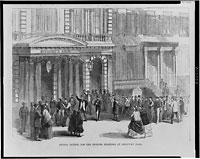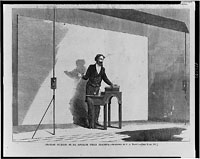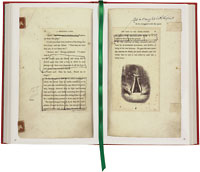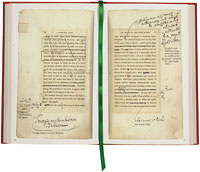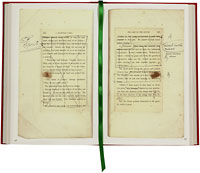On Stage with Charles Dickens
A facsimile edition of Charles Dickens’ personal prompt copy of A Christmas Carol focuses the spotlight on the author’s theatrical career. By Jonathan Shipley
“Promptly at 8 P.M.,” a writer for San Francisco’s Alta California newspaper wrote that night of December 31st, 1867, “unannounced, and without waiting for any stamping or clapping of hands to call him out, a tall, ‘spry’ (if I may say it,) thin-legged old gentleman, gotten up regardless of expense, especially as to shirt-front and diamonds, with a bright red flower in his button-hole, gray beard and moustache, bald head, and with side hair brushed fiercely and tempestuously forward, as if its owner were sweeping down from a gale of wind, the very Dickens came!”
The very Charles Dickens, arguably the most famous author in the world at that time. According to Harper’s Weekly, crowds began gathering the previous night to buy tickets for this performance. “Not less than 500 persons, including two women, were in the line.”
Dickens was an old 55 when he appeared on stage unannounced - he would die less than three years later. The reporter for the newspaper was a 32-year-old named Mark Twain. Dickens read aloud to Twain, and the rest of the audience at Steinway Hall in New York City, from his well-known novel David Copperfield. “Mr. Dickens,” Twain continued, “had a table to put his book on, and on it he had a tumbler, a fancy decanter, and a small bouquet.”
It would have been a similar tableau the week before in Boston on Christmas Eve. Dickens, in the festive atmosphere, read A Christmas Carol, to the adoration of the crowd. The story of Ebeneezer Scrooge being visited by his deceased partner Jacob Marley, followed by the Ghost of Christmas Past, the Ghost of Christmas Present, and the Ghost of Christmas Yet to Come, moved Bostonians to tears. One observer noted that Tiny Tim’s death “brought out so many pocket handkerchiefs that it looked as if a snow-storm had somehow gotten into the hall without tickets.” Another member of the audience, Mr. Fairbanks, was so influenced by the reading he closed his factory on Christmas Day and sent every employee a turkey.
On the lectern sat Dickens’ prompt copy, which contained the text of the tale prepared for public performance. It had the authors’ markings in it—the excised passages, the edited paragraphs, the marginalia in Dickens’ own hand reminding him know how to inflect certain words or lines, when to turn a page, how to deliver particular phrases. It was, one assumes, indispensable to the performer.
Only one known prompt book of A Christmas Carol exists, and it now resides in the Henry W. and Albert A. Berg Collection of English and American Literature at the New York Public Library under the curatorial eye of Isaac Gewirtz. A faithful facsimile of the prompt copy has recently been published by Levenger Press with Gewirtz’s introduction. Edited by Mim Harrison, the new edition has been reproduced at the actual size of the original. It is printed in four-color to show the various markings Dickens made; he used different inks. “We thought it would be an ideal way,” Harrison said, “to give readers a window into how Dickens’ mind worked.” Levenger splurged on four-color, Harrison added, “so that every one of Dickens’ markings would come through in the facsimile.” The new edition includes the emended script, recommended reading, and an essay on how to read the notes Dickens scribbled throughout the prompt copy. It is bound in linen-covered boards with gold foil decoration.









